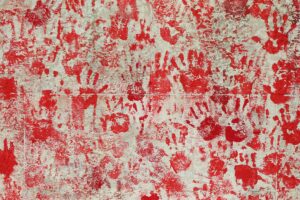This Article comes from the Globe and Mail.
From Cowessess in Saskatchewan to Tk’emlúps te Secwépemc in B.C., First Nations have used ground-penetrating radar to find the remains of lost children – and for Canadians, it’s been a reckoning about more than just residential schools.

Red handprints cover the pedestal of the just-toppled Queen Victoria statue outside the Winnipeg legislature on Canada Day, which became a day of action for Indigenous people and residential-school survivors across the country.
SHANNON VANRAES/REUTERS
From coast to coast, Indigenous people have long suspected that former residential schools – colonial institutions designed to separate children from their cultures – still had unmarked graveyards that hid their horrific human cost. Hundreds of such graves have been reported this summer as First Nations have used ground-penetrating radar, archival detective work and the help of experts to find the remains of long-lost loved ones.
Three such communities – Cowessess in Saskatchewan, and Tk’emlúps te Secwépemc and Ktunaxa in B.C. – have gotten most of the attention this summer, but they aren’t the only ones with unmarked graves and won’t be the last to be brought to light. Here’s a primer on what’s they’ve found and how it’s rekindled Canadians’ conversations about the colonial legacy, reconciliation and what should be done to give the children’s remains proper respect.
Need to talk with someone? There is a national Indian Residential School Crisis Line (1-866-925-4419). In B.C., a toll-free First Nations and Indigenous Crisis Line (1-800-588-8717) is offered through the KUU-US Crisis Line Society.
-
What’s been found at the residential school sites
-
How does ground-penetrating radar work?
-
What is a residential school? Some context
-
What will it cost to find all the unmarked graves?
-
New calls for action
Finding more unmarked graves is only one of the things Indigenous leaders and advocates are pressing Ottawa to do to help residential-school survivors and follow through on the TRC’s recommendations. These include:
- Action at the Vatican: A papal apology for residential schools was one of the goals recommended by the TRC, and Mr. Trudeau has asked the Vatican to make that happen, without result. Pope Francis spoke about the Kamloops graves at a Sunday service on June 6, but it wasn’t an apology; instead, he expressed his “closeness with the Canadian people” and said political and religious authorities should “continue to collaborate with the determination to shed light on this sad affair and to commit humbly to a path of reconciliation and healing.”
- Monuments and naming: Governments and public institutions are under renewed pressure to take down monuments or rename institutions that honour people who helped build the residential-school system in the 19th century, such as prime minister Sir John A. Macdonald and educator Egerton Ryerson. In Toronto, a Ryerson statue was torn down by protesters at the university named after him; in Charlottetown, city council voted to permanently remove a Macdonald statue that they had previously considered keeping with new signage.
- Oaths: Two of the TRC’s calls to action involved changing the Canadian citizenship oath to include references to Indigenous people and treaty obligations, and the federal government has fast-tracked a bill, C-8, to do that. It still needs to pass the Senate. The new oath would read: “I swear (or affirm) that I will be faithful and bear true allegiance to Her Majesty Queen Elizabeth the Second, Queen of Canada, Her Heirs and Successors, and that I will faithfully observe the laws of Canada, including the Constitution, which recognizes and affirms the Aboriginal and treaty rights of First Nations, Inuit and Métis peoples, and fulfill my duties as a Canadian citizen.”
- Day of commemoration: Federal MPs were already nearing the final vote on C-5, a bill to make Sept. 30 a national day to commemorate residential-school victims and survivors, when the Kamloops discovery was made public. The bill was approved in the House and Senate and received royal assent in quick succession.
